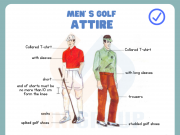If you DESIRE to take advantage of your game, you first need to create and master the golf swing sequence.
The top golfers in the world follow a certain sequence, while some do it entirely differently than other golfers. Although, there is a specific or universal sequence to get YOU started on your golf journey.
All great players begin their journey with a consistent golf swing sequence, and we’re here to break it down for you.

The Correct Golf Swing Sequence
To achieve efficient speed, proper direction, control, and angle, you NEED to maintain your golf swing position.
With sufficient practice, you’ll eventually get the hang of this golf swing sequence.
There are 7 main sections to a proper golf swing:
- Address position
- Takeaway
- Backswing
- The transition
- Downswing
- Impact, and
- Follow-through
Overall, these 7 body movements may feel awkward at first. But once you get the hang of each movement, it will be much simpler and more natural when you put it together.
Step 1: Address Position
The first movement is the address. So, what consists of the address?
The address consists of your grip, posture, stance, and the position of the golf ball.
The way you grip your golf club is the most IMPORTANT step. You wouldn’t want to see your golf club on the ground or mid-air after you swing.
Your Grip
You have 3 choices of grip:
- Overlap
- Interlock
- 10-finger
Most players commonly use THE OVERLAP. To do the overlap grip, you need to position your pinky on your right hand should overlap the pointer finger on your left hand.
The famous Tiger Woods grips his golf club this way at the INTERLOCK GRIP.
Position the pinky finger on your right hand should go-between (interlock) your pointer finger and middle finger on your left hand.
Junior players commonly use THE 10 FINGER GRIP because they have smaller hands to don’t struggle. All 10 FINGERS are on the golf club (no overlap or interlock).
Your Posture
Now that we’ve covered the grip, it’s time to move on to your posture.
The center of your upper spine, your knees, and the ball of your feet should line up on top of each other. Bend your waist, keep your back straight with your knees slightly flexed, and let your arms hang down.
Your legs should be SHOULDER-WIDTH APART. The problem that most amateur golfers struggle with is a narrow stance.
If your stance is too narrow, you will end up losing your balance; a wider stance, on the other hand, makes it difficult to rotate.
The Ball Position
The golf ball position depends on the club that you are hitting.
If you are hitting a wedge shot, the ball should be in the middle of your stance. The point of the ball should be near your front foot if you are hitting the driver.
Once you have gotten these all checked out, that’s one step off the list!
Step 2: Takeaway
The second step to our golf swing sequence is TAKEAWAY.
Takeaway doesn’t determine your overall golf swing as it is only a small part, but a lot can go wrong when done incorrectly.
This step is the portion of the backswing from setup to the point where the club is parallel to the ground.
No matter how well the swing is executed when the clubhead has a misaligned point during the takeaway, your shot will go in the wrong direction.
Your hands should be slightly forward of the ball when you begin your takeaway to ensure this doesn’t happen. You can also practice the golf swing with a small “forward press” with your hands.
If a golfer is experiencing too much tension, they begin their golf swing with their arms instead of using their wrist. The result of this would then be pulling the club off the swing plane.
Another common mistake that amateur golfers make is the hands being too far behind the ball, breaking your wrist early, and lifting the club.
How to Practice the Takeaway Golf Swing Sequence
Position a sign (or another object) between your body and your hands in your swing stance.
Butt the club up against the sign.
Keep the butt of the club against the sign as you move through the takeaway. This prevents you from leading with your hands.
Step 3: Backswing
The third step on the golf swing sequence is the back swing, and a great backswing prepares us for an accurate shot.
The aim of a great backswing is the following:
- Positions the golfclub in a good position to hit the ball straight.
- Stores energy and creates distance from the golf ball to generate club head speed into impact.
The components of a proper backswing are the following:
- Club head
- Arms
- Torso/Chest
- Hips
To give you a general overview of the 4 components of the downswing, you have to follow these CRUCIAL steps.
The club has to be the first to move because the club head is the furthest thing to travel from the ground up to the top of the golf swing.
With this in mind, the arms, torso/chest, and hips will follow accordingly after you downswing.
After the ball has left the ground from a proper backswing, your body will unwind in the opposite direction.
Most amateur golfers take the backswing entirely TOO FAST. In their mind, more backswing speed equals more distance.
If you’ve mastered downswing completely, you’ll be able to hit a straight shot from now on!
Golf Backswing Sequence: Down the Line and Face on
In the textbook, if we turn our body TOWARDS the target during the downswing, we’ll be able to deliver the club on a square path through impact.
Furthermore, you want the shaft of the club to stay in line with the target. It may be difficult to notice this on your own as the rest of your positions start to change.
Overall, you want your club to end up parallel to the ground. If you allow it to end up not parallel to the ground, you’ll experience a bad shot.
Club Face Angle During Backswing
To achieve an accurate backswing, you want to keep the clubface in its neutral impact position, meaning you should CONTROL your golf grip the movement of your arms and wrist.
During your downswing, you want to keep your back elbow (right elbow for a right-handed player) close to your rib cage to get the golf ball into the target line and better balance.
Too often, amateur golfers will allow that elbow to flare out, sometimes called a “chicken wing.”
Step 4: The Transition
The transition is considered the pause at the top of your swing.
The transition is the brief moment when your backswing ends, and your downswing starts.
This sequence is very short but does not underestimate it as this could ruin your perfectly built golf swing and balance.
The most common mistake that amateur golfers can experience is getting too quick into their transition. This leads to various flaws, loss of power, and poor impact position.
To not compromise your impact, you want a slight pause before starting.
To add, in this stage, your wrist will start to hinge more than it did in the takeaway. Begin using your shoulders to turn your body to create a turning motion.
It’s also where the player shifts their weight back towards the lead foot.
Remember that the core of this step is the way your lower body moves and NOT your hand lead. Your lower body must begin to rotate towards the target after the club reaches the height of the backswing.
Your main goal is to still be balanced in time for this step. You want to make sure that your arms, head, feet, elbow, and shoulder move in unison. To do this, you have to keep your backswing low.
Step 5: Down Swing
Here are the tips and tricks on how to properly execute the action! These are to ensure that your swings will be clean, smooth, and good enough for you to do well in your future games!
Keep the Hinge in Your Wrist
The full hinge set progressively in the backswing should be kept intact as you bring in the downswing.
The wrists only unhinge very late in the ” RELEASE ” process to achieve a proper swing.
Uncoil Your Hip
The hip should be the FIRST in reversing action – or uncoiling – when reaching the top of the swing.
The correct golf swing is for your hip to reach the top last; that order is reversed in the downswing, beginning to turn back first and the rest to follow.
Hip Should Stay Inside the Box
Your hip is the first to move.
Your hip should move by UNCOILING while staying mostly in place with the ground with the upper body rotating back along its spinal axis.
The Head of the Golf Club Should Follow an Inside-Square-Inside Path
The ideal club path is called the inside-square-inside path.
It is best to avoid seeing the club come inside to become ‘OUTSIDE’ after the impact point.
While those players who suffer from an outside-in club path will see the club come down during this stage outside of the target shot and continue inside after impact.
Transfer Your Weight to Your Left.
Your mass should transfer onto your front foot when you start to bring your hand down during this stage.
This should continue progressively through the ROTATION of your hip and your shoulders.
A Faster Downswing
Another important point to make is to MAINTAIN your wrist hinge on the club for as long as possible.
Again, many amateurs will release their wrist hinge on the club almost immediately after the transition point.
To add, your backswing is much “calmer” than your down swing; you want this to be paced more vigorously. The inability to do so leads to a swing error.
Throwing your arms out down during this point will result in a loss of power.
And the same thing just to afterward, once we had that feeling of getting the arm to drop in your hip open and then come in through.
If you’ve mastered this completely, you’ll be able to hit a straight shot from now on!
Step 6: Impact Position
Now that we are past the 5th point, we are moving on to the MOST important sequence of your golf swing.
There are 3 main target positions:
- Regular fairway shot
- Driver shot, and
- Shot from the sand
Regular Fairway Shots
In this traditional shot, you want to keep the clubhead moving in a slightly DOWNWARD motion until it gets to hit the ball.
To add, you also want to ENSURE that the club will slightly hit the ball on the ground.
Driver Shot
This is also called the “ball off the tee.”
The club should also hit the ball INSIDE until it leaves the ground.
Shot From the Sand
Before reaching the ballpoint, you first want to impact the sand to make it FLY through the air.
Step 7: Follow Through
The follow-through and finish is the point that often works when everything else before it lines up.
While you are in your follow-through point, you should be BALANCED on your non-dominant leg until the ball has landed.
You want to strive for as much extension as possible. This will help you hit straighter, more powerful shots.
At this point, you should observe your overall performance, such as your follow-through extension.
Questions to Ask After Your Follow Through
Did your arms fully extend, or did they just slightly extend out to the target after impact, or do they collapse?
Did you properly get the ball off the ground?
Did your knee bend too much like other sports?
Frequently Asked Questions (FAQ)
Do you still have questions regarding the topic that haven’t been answered in the article? Here are the most frequently asked questions that may answer your concerns!
What Point of My Figure Should Move First?
The order is the opposite when starting down: The hip moves first, pulling the shoulders behind them.
Your hip continues to guide all the way through, turning past the ball and pulling the shoulder back into the same place they had at the address the moment you strike the ball.
How to Make a Difference With My Golf Putt?
You can start with these strategies to change your game and make more birdies.
- Set-Up and Alignment. Set up and alignment are some of the most important parts of putting. …
- Learn to Judge Distances.
- Visualization.
- The Horizontal Side-to-Side Survey.
- Patience and Confidence.
- The Putting Drill.
Should I Roll My Wrists During a Golf Putt?
ROLL IT!
During the impact, your wrist rolls over as the golfer transfers from the takeaway to contact and then the follow-through.
If the wrist rolls too forcefully, the teeoff likely will hook. If the wrist does not roll enough, the teeoff likely will slice to the right.
What Is the Proper Grip?
You should have your hand on the club and your trail hand just underneath it in simplest terms.
The grip should run down your fingers and palm in your hand, and the palm of your trail hand should sit just on top of it.
Keep it ALIGNED with your hands rather than slightly behind them when gripping it firmly.
This is your game foundation, and it’s the only connection you have with your club — so treat it wisely!
Conclusion
Now that we’ve listed down the way to master the order, you can start to test this out and see if it works for you!
Remember that this is the FOUNDATION of your game. You first have to make sense of all these before you can strike the ball far and wide.
Thank you for reading! We hope that your future golfing experiences will be better and your game will VASTLY IMPROVE!
Source: https://barryrhodes.com/how-to-master-the-proper-golf-swing-sequence/


























